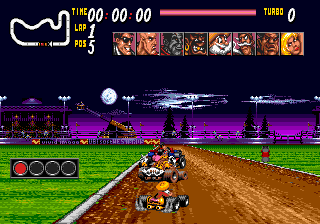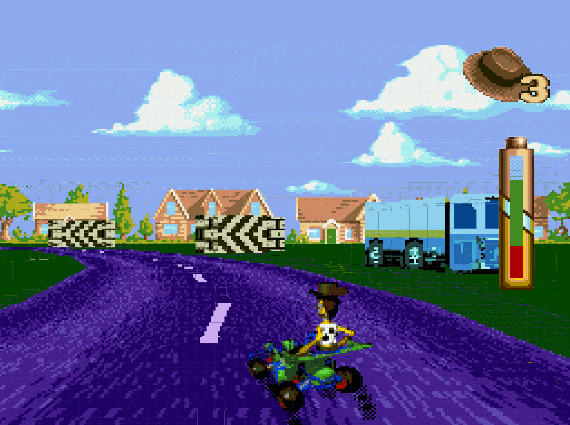cireza
Banned
This would have enabled at least two better ports : Castlevania and Doom.So weird that Saturn didn't support 256x224.
This would have enabled at least two better ports : Castlevania and Doom.So weird that Saturn didn't support 256x224.
This would have enabled at least two better ports : Castlevania and Doom.
I know this very well. But the PSX version running in 256 * 224, the engine would have run better it was not forced to run in 320 * 224 (on top of being ported like shit and not taking into account the strengths of the Saturn).The Doom port was just entirely fucked up from the start. It was a bad PSX conversion that was rushed to shit.
I don't think it was that bad, though maybe I'm wrong so take this with a grain of salt. CD 68k should have been able to run during all this, it had whole 512KiB of RAM to itself.
No, DKC games don't use additional chips.Were any chips used to play dk2 music? This stuff still sounds incredible.
https://youtu.be/wYyMNXM8Kgg
Wait, so every sound that the SNES produced had to come from samples being modulated? You just couldn't send it instructions to play sounds? Did the system come with base samples right in the hardware or was it all cart dependent?
nope, the only of era sound chip that did that was on the AmigaAnother reason might be sound: since the SNES uses samples, a pretty significant part of the ROM space had to go towards storing them and graphics might have had to be trimmed down to get everything to fit.
nope, the only of era sound chip that did that was on the Amiga
This one was by the same people as kawasaki challenge, but it seems like there there can be a lot more cars on the track at once, with much bigger sprites too.
https://www.youtube.com/watch?v=GrMMfjsYez0
Noooo. The SNES was most definitely sample based.
Talking about impressive sound, an FM only song composed by Tim Follin for the cancelled Time Trax for genesis
However, I think the choice by nintendo for the sound chip used did allow for the sound common on the NES to be even better
I partically misread your post: The SNES only has one PCM channel, like the genesis. Not a lot of games used much for samples past short simple things for cart size reasons, and even then it was usually reserved for sound effects
Seriously?
https://www.youtube.com/watch?v=cbreFmRDN3E
you can still listen to that stuff in the year 2017. -And it's really hard to find pleasing music out of the Megadrive games.

Yeah, I'm wrong and I blame like every game using the same samples for it. Even so, I doubt the added size of a few samples would result in cut down animation as much as reduced cart sizes due to nintendo charging more
The Doom port was just entirely fucked up from the start. It was a bad PSX conversion that was rushed to shit.
No, DKC games don't use additional chips.
It's all stock SNES doing.
There's a big difference. One is a drive-by ignorant post, the other is not.
The SNES CPU was more powerful, the fact that it is slower doesn't mean they "cheapened out".
I could say the same thing about the Genesis sound chip. Sega was cheap and used a old and cheap sound chip.
That's pretty insane. How big was that cart?
Only once : Virtua Racing.
gonna be twice soon
Finally I can dive into the nostalgia sea and take out my SEGA flag again.
Megadrive >>>>> SNES, fight me GAF.
It's all samples that come from the cart. There are no built in sounds.
The SNES sound system contains its own 8 bit processor and boot rom and 64k of ram. It's quite independent from the rest of the system, so much so that if the gamecode crashes, the music will keep on playing. Also, there were no tonal differences between pal and ntsc systems unlike most other systems at the time that would pitch their music down for PAL releases.
On the negative side, all of your samples and code had to fit in that small ram space and it wasn't possible to change samples on the fly. You had to pause the sound, flush the memory and reupload new samples/code and play again.
Because they already had Blast Processing.
6 MB (48 Mbit).That's pretty insane. How big was that cart?
Thanks for posting all those. I did not knew about this youtuber.
I am pretty sure that the Genesis was more capable overall in terms of animation. This includes Disney games, for example. Can't explain why however.
Also, I think that Mortal Kombat games on SNES are actually using horizontally compressed sprites (in order to be of the correct size once the 256 * 224 resolution is stretched to 4/3 by the TV). So this means smaller sprites, so less space required in the rom.
Street Fighter on Genesis runs in the 256 * 224 mode, so that's the same as the SNES game, so the sprites must pretty close on each console (of course, the colors won't because the Genesis is limited, and the palettes were remade). I don't know if there are more animations.
It really suffered with PCM audio though. Compare the voice samples of SNES's SF2 Turbo with the Genesis's SF2 Champ Edition.eh its not that impressive, the limiter here is rom space the megadrive is just as capable of it (though with less colours tbf)
it could have done with better tools for sure, but the megadrives sound chip is fine and is capable of great music.
https://youtu.be/Xln0a0HIX5Y
The reason is the Mega Drive is a Mark III with some lower powered System 16 board chips added. It has hardware backward compatibility.Oh wow, thought it was 86, but yeah, weird how great the colour depth was on the PCE for the time. Also, Snes has less on screen colours. Weird.
I would like to know how much money sega saved on that decision and what the hardware engineer must have thought about it.
I also want to bring up that the Neo Geo could only shrink sprites. It couldn't scale them bigger than their default size nor rotate them.
Man, all the 16bit machines were so weird in their trade offs.
There are several, they have been around for years and are garbage. Tectoy has been selling F-grade build quality built-in-games Segas for 20 years.A better question would be why is there no mini sega genesis slash mega drive
There are several, they have been around for years and are garbage. Tectoy has been selling F-grade build quality built-in-games Segas for 20 years.
The reason is the Mega Drive is a Mark III with some lower powered System 16 board chips added. It has hardware backward compatibility.
And the Master System/Mark III is just a SG1000 (Colecovision/MSX1) with an extra video mode.
SNES was also a double clocked Famicom with a bunch of fancy subsystems (like the entirely separate sound system), but planned cart upgrades from day 1 (a launch game had a DSP chip!).
PC Engine is the best designed hardware of the generation, small, elegant and well engineered with quality plastic too. It was the Gamecube of that gen.
The reason is the Mega Drive is a Mark III with some lower powered System 16 board chips added. It has hardware backward compatibility.
And the Master System/Mark III is just a SG1000 (Colecovision/MSX1) with an extra video mode.
SNES was also a double clocked Famicom with a bunch of fancy subsystems (like the entirely separate sound system), but planned cart upgrades from day 1 (a launch game had a DSP chip!).
PC Engine is the best designed hardware of the generation, small, elegant and well engineered with quality plastic too. It was the Gamecube of that gen.
Great posts. So actually, it was only MK II that used the technique of reducing the size of the sprites.I made posts like this quite a few years ago that cover this:
Genesis/ Mega Drive and SNES sprite/ resolution comparison of Mortal Kombat 1 and 2: http://www.neogaf.com/forum/showpost.php?p=185103989&postcount=233/
Screen resolution comparison of Street Fighter II for the SNES and Genesis/ Mega Drive: http://www.neogaf.com/forum/showpost.php?p=185125658&postcount=249
Comparison between the cutscenes in Toy Story between the SNES and Genesis: http://www.neogaf.com/forum/showpost.php?p=210309135&postcount=319

-1458965880.png)


%20(Beta).png)
Agree with this. Worst limitation of this otherwise fantastic system.Having just a single BG layer makes it quite a lot more limited.
It really suffered with PCM audio though. Compare the voice samples of SNES's SF2 Turbo with the Genesis's SF2 Champ Edition.
It was really limited to a certain timbre. I'm not denying that some truly epic music was composed for it like THIS, but again, it could not stack up in its PCM playback abilities at all.
Great posts. So actually, it was only MK II that used the technique of reducing the size of the sprites.
You probably already know this, but for info : concerning Toy Story, those cut-scenes also go beyond the 64 simultaneous colors on screen by switching palette on the fly (a common practice with the Genesis, for water effects or any effects that divides the screen in two horizontally).
For a pretty long time, I thought that Street Racer on Genesis was actually using this method because of how incredibly colorful the game is. You could split the screen horizontally where the tracks appears. But it seems that it is not the case. Simply a very masterful use of the color palette.

-1458965880.png)


%20(Beta).png)
(SNES for comparison, pretty great use of the colors of the system)
Putting pictures of those two games side by side actually shows well the differences between both consoles. Also, you can see the differences between the track layouts in the upper left corner.

That's pretty insane. How big was that cart?
Not much impressed by Toy Story racing segment, yes on the sides the objects scale but the road and curves are faked like in Outrun.I never would have guessed that Street Racer was on the Genesis back then, maybe it was only released in Europe? Yeah, the SNES game used Mode 7, but this version does use an interesting colour pallete swap routine to create a textured map look. Really neat, actually.
Going back to Toy Story, it had an impressive driving stage like this too..
But this one also seems to use textured mapped polygon graphics to some extent. This stage was never in the SNES game as well.
Great posts. So actually, it was only MK II that used the technique of reducing the size of the sprites.
You probably already know this, but for info : concerning Toy Story, those cut-scenes also go beyond the 64 simultaneous colors on screen by switching palette on the fly (a common practice with the Genesis, for water effects or any effects that divides the screen in two horizontally).
For a pretty long time, I thought that Street Racer on Genesis was actually using this method because of how incredibly colorful the game is. You could split the screen horizontally where the tracks appears. But it seems that it is not the case. Simply a very masterful use of the color palette.

-1458965880.png)


%20(Beta).png)
(SNES for comparison, pretty great use of the colors of the system)
Putting pictures of those two games side by side actually shows well the differences between both consoles. Also, you can see the differences between the track layouts in the upper left corner.
Agree with this. Worst limitation of this otherwise fantastic system.
Byuu is making a Genesis emulator?!?I'd like to hear what Byuu's take is on the two systems. He's currently working on a Genesis emulator and he knows the SNES inside and out.
Let me just look in a mirror and repeat: Byuu.. Byuu... Byuu!
One of the rare case of a multiplatform (PS1/SAT) 3D game which is clearly superior on Saturn (due to the heavy use of the VDP2).For funsies, here's the Saturn vs. PS1 versions:
https://www.youtube.com/watch?v=c49xKd-C7FA
Here's a nice side-by-side video of Street Racer:
https://www.youtube.com/watch?v=KRzmWBs02AQ
I actually think the MD version looks better here.
For funsies, here's the Saturn vs. PS1 versions:
https://www.youtube.com/watch?v=c49xKd-C7FA
No, DKC games don't use additional chips.
It's all stock SNES doing.
Out of those the MD version is a 2D racer (like outrun), while the others are full 3D racers. The big difference is not only the graphics, but there's for example no racing line in 2D racers. No matter if your are on the outside or the inside of a curve the length is the same.
That's the revelation that where the Mode7 racers on SNES. Proper 3D racing at good framerates. Only on a plane with some sprites, but light years ahead of 2d racers in terms of gameplay.
And to think that the Mega Drive launched a whopping 25 months before the Super Famicom. Man that was a beast console back then.
